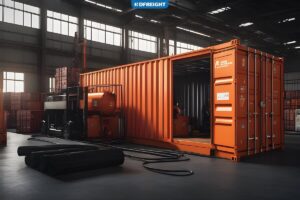A container can be loaded and unloaded in various ways, depending on the type of container, the equipment available, and the kind of cargo. There are some essential things to remember to load and unload a container. In this blog post, we’ll cover the basics of how to load and unload a container safely and efficiently.
Table of Contents
Equipment Used to Load and Unload a Container
A container is a large, standardized shipping container used to store and transport materials and products. These containers are designed and manufactured to be solid and durable, able to withstand the rigors of international shipping.
There are many different containers, each designed for a specific purpose. The most common type of container is the 20-foot (6.1 meters) intermodal container. This container is used for the majority of international shipments. There are a variety of different methods used to load and unload containers. The most common forms include:
- Container Cranes: Using a crane is the most common method of loading and unloading a container. A crane can easily lift the container onto and off a truck or train. The only downside to using a crane is that it is somewhat slow, so if time is a factor, another method may be better.
- Forklifts: A forklift can load and unload a shipping container, but it is not as common as using a crane. A forklift can lift the container onto and off a truck or train, but it is not as stable as a crane and can drop the container if not used carefully.
- Container Straddle Carriers: Straddle carriers are container handling equipment used in many ports and terminals worldwide. They are used to lift and move containers from one location to another and can be used to load and unload ships, trucks, and trains. Straddle carriers are large, heavy machines and can be operated by one or two people.
- Reach Stackers: Reach stackers are container handling equipment used in logistics and shipping. They are designed to move and stack containers on top of each other and can be used to load and unload container ships. Reach stackers can also move containers around a warehouse or storage facility.
- Roll-on/roll-off: Roll-on roll-off (RORO) is a method used to load and unload a container that is becoming increasingly popular. RORO involves loading the container onto a truck or train with a ramp that the container can roll on and off. This method is faster than a crane and less likely to damage the container.
- Lift-on/lift-off: A lift-on/lift-off (LOLO) operation is a shipping method used to move cargo that is too large or too heavy to be containerized. LOLO operations require specialized equipment and trained personnel to load and unload the shipment. They are typically used for oversized or overweight items such as construction materials, vehicles, and machinery. LOLO operations are typically conducted at port facilities, and the cargo is loaded onto the ship using a crane or other heavy-lifting equipment. Once the freight is on board, the ship sails to its destination, and the cargo is unloaded using the same equipment.
- Front-End Loaders: A front-end loader is a type of heavy equipment most often used in shipping and construction. This equipment moves large amounts of material, such as dirt, sand, gravel, and other materials, from one location to another. In many cases, a front-end loader is used to load these materials into a dump truck or vehicle that can then transport them to the desired location.
- Back-End Loaders: Back-end loaders are one of the most commonly used pieces of equipment in the shipping industry. They are used to load and unload containers from ships and move containers around on the docks. Back-end loaders are very versatile and can be used in a variety of other applications as well.
Once the containers are loaded or unloaded, they are ready to be transported to their final destination. The methods used to load and unload containers directly impact the transportation process’s efficiency. Using the proper equipment can help ensure that the containers are safely and securely loaded and unloaded. As you can see, there is a wide range of machines that are used in the process of loading and unloading a container. Each device has its specific purpose and function. To ensure that the process runs smoothly and efficiently, all of the machines must be used in the correct order and in the right way.
What You Will Need to Load and Unload a Container
You will need a few things to load and unload a container. First, you will need a way to get the container onto and off the truck. This can be done with a crane or a forklift. If you are using a crane, you will need to have a way to secure the container to the crane. Second, you will need something to tie down the load inside the container. This can be done with rope, straps, or nets. You may need straps or other securing devices. If you want to load or unload a container with hazardous materials, you will also need to take special precautions to ensure the safety of yourself and those around you.
Third, you will need to be able to close the container once the load is inside. This is done with a seal or a locking system. Finally, you will need a way to unload the container once it reaches its destination. This can be done with a crane or a forklift.
Tips and Tricks
If you’re planning on using a shipping container for storage or transportation, there are a few things you need to know in order to load and unload a container. Here are a few tips to make the process go smoothly:
- Inspect the container before load and unload a container to ensure no holes or tears in the walls or floor.
- Use a forklift or other machinery to load and unload heavy items.
- Place lighter items on top of heavier items.
- Use dunnage (wooden boards or other material) to create a level surface and prevent items from shifting during transit.
- Secure all items in the container with straps or other devices to prevent them from moving around.
- Make sure the container is adequately ventilated to prevent condensation and mold growth.
- If possible, avoid storing food items in the container to prevent attracting pests.
- Keep the container clean and free of debris.
- Inspect the container periodically during storage to ensure it is in good condition.
- When ready to move the container, properly secure it to prevent it from tipping.
- Hire a professional shipping company to load and unload a container to avoid injury and damage to your belongings.
Following these tips will help you load and unload a shipping container safely and efficiently.
Conclusion
Loading and unloading a container is a relatively simple process, but it’s essential to do it safely and efficiently. Following the steps outlined in this blog post can ensure a smooth and successful way to load and unload a container operation.
DFreight can help you get your goods to their destination safely and on time so you can focus on your business. Contact us today to learn more about our services and how we can help you get your goods where they need to go.
FAQs
How do you load a container?
To load a container, the goods must be placed into the container to ensure stability and prevent damage.
What are the risks of load and unloading a container?
The risks of loading and unloading a container include accidents, injuries, and damage to goods.
How can you prevent accidents when loading and unloading a container?
Some ways to prevent accidents when loading and unloading a container include using proper equipment, following safety procedures, and having a plan in case of an accident.
Who is responsible for loading and unloading a container?
The responsibility for loading and unloading a container typically falls on the shipper, the carrier, or the consignee.














